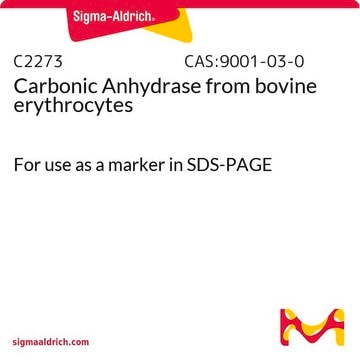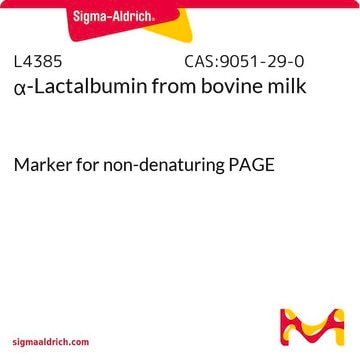L6385
α-Lactalbumin from bovine milk
For use as a marker in SDS-PAGE
Sinonimo/i:
alpha-lactalbumin
Autenticatiper visualizzare i prezzi riservati alla tua organizzazione & contrattuali
About This Item
Prodotti consigliati
Origine biologica
bovine milk
Livello qualitativo
Forma fisica
powder
PM
~14.2 kDa
Confezionamento
vial of 5 mg
tecniche
electrophoresis: suitable
Solubilità
H2O: soluble 10 mg/mL
N° accesso UniProt
Temperatura di conservazione
2-8°C
Informazioni sul gene
cow ... LALBA(281894)
Cerchi prodotti simili? Visita Guida al confronto tra prodotti
Categorie correlate
Descrizione generale
α-Lactalbumin is a small, globular, whey protein that has been found in all milk studied to date. It is a metalloprotein of approximately 14 kDa produced in the mammary glands.
Applicazioni
α-Lactalbumin from bovine milk is suitable for use:
- as an electrophoresis marker, with a molar mass of approximately 14,200Da
- in a study to investigate selective binding of proteins on charged surface iron oxide nanoparticles via reverse charge parity model
Azioni biochim/fisiol
α-Lactalbumin consists of a single polypeptide chain with 8 cysteines which form disulfide bridges. α-Lactalbumin binds several metal ions, including calcium, which is thought to play a role in the regeneration of native α-lactalbumin from the reduced, denatured form. α-Lactalbumin also has a distinct zinc binding site that is thought to play a role in the binding of the lactose synthase complex. The mature protein consists of 123 amino acid residues (14 kD), and it has a three-dimensional structure with 1.7 Angstrom resolution, demonstrating four a-helices and a triple stranded antiparallel β-sheet.
Alters the substrate specificity of galactosyltransferase to increase the rate of lactose formation; the complex of galactosyltransferase and α-lactalbumin is called lactose synthase. Site-directed mutagenesis of Asp87 or Asp88 to Ala completely abolishes the strong calcium binding affinity and reduces the stimulation of lactose synthase to <3.5% of the maximal rate.
Certificati d'analisi (COA)
Cerca il Certificati d'analisi (COA) digitando il numero di lotto/batch corrispondente. I numeri di lotto o di batch sono stampati sull'etichetta dei prodotti dopo la parola ‘Lotto’ o ‘Batch’.
Possiedi già questo prodotto?
I documenti relativi ai prodotti acquistati recentemente sono disponibili nell’Archivio dei documenti.
I clienti hanno visto anche
Haidong Tan et al.
Biotechnology letters, 27(16), 1177-1182 (2005-09-15)
Recombinant human interleukin-1 receptor antagonist (rHuIL-1ra) was produced in E. coli as an inclusion body. rHuIL-1ra was purified to Over 98% purity by anion exchange chromatography after on-column refolding. The optimized processes produced more than 2 g pure refolded rHuIL-1ra
Guanhao Bu et al.
Journal of the science of food and agriculture, 90(12), 2015-2020 (2010-06-29)
The main whey proteins alpha-lactalbumin (alpha-LA) and beta-lactoglobulin (beta-LG) are considered as the major allergens in cow's milk. Microbial fermentation can produce some proteolytic enzymes, which can induce the degradation of milk protein allergens. In this study, the effects of
S Yefimov et al.
Journal of biochemical and biophysical methods, 42(1-2), 65-78 (2000-01-27)
Five SDS-proteins, ranging in molecular weight from 14 to 66 kDa, were detected without covalent fluorescent labeling by the automated gel electrophoresis apparatus with intermittent fluorescence scanning (HPGE apparatus, LabIntelligence) during electrophoresis in barbiturate buffer in the presence of Cascade
Eric Lorent et al.
Vaccine, 26(3), 399-410 (2007-12-14)
The structure of the ectodomain of the hepatitis C envelope glycoprotein E1 (E1s) was characterised by spectroscopic methods. Monomeric E1s was purified from a mammalian and from a Hansenula polymorpha cell lysate, and cysteine-blocked monomers were reconstituted into stable particles.
Selective binding of proteins on functional nanoparticles via reverse charge parity model: an in vitro study.
Ghosh G, et, al.
Materials Research Express, 1 (2014)
Il team dei nostri ricercatori vanta grande esperienza in tutte le aree della ricerca quali Life Science, scienza dei materiali, sintesi chimica, cromatografia, discipline analitiche, ecc..
Contatta l'Assistenza Tecnica.













